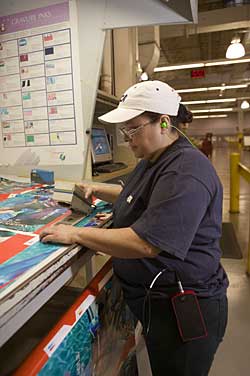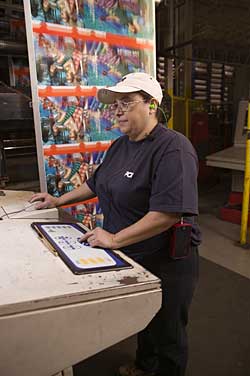
Sounds Good to Me
Tell them this: Hearing PPE is required in an area because there is no other feasible solution to protect them from an already identified, known hazard.
- By Randy DeVaul
- Mar 01, 2007
 MORE than 30 million workers are exposed to hazardous noise levels
in the workplace. It is estimated that costs just for work-related
hearing disability exceed $242 million annually! The National Institute
for Occupational Safety and Health reports hearing loss is one of its
priority areas for research for this century. Noise-induced hearing
loss is the most common way for a person to lose hearing; one out of
every 10 Americans suffers a loss of hearing severe enough for it to
affect daily conversation and how normal speech is understood.
MORE than 30 million workers are exposed to hazardous noise levels
in the workplace. It is estimated that costs just for work-related
hearing disability exceed $242 million annually! The National Institute
for Occupational Safety and Health reports hearing loss is one of its
priority areas for research for this century. Noise-induced hearing
loss is the most common way for a person to lose hearing; one out of
every 10 Americans suffers a loss of hearing severe enough for it to
affect daily conversation and how normal speech is understood.
It is no wonder the Occupational Safety and Health Administration
has implemented a hearing conservation standard for employers to
follow. Noise exposure at work, though, is not our only exposure. More
young people are starting their working careers with significant
hearing loss already from noise exposures at home or in the
environment. It's sad to think we are causing our children to go deaf
through poor choices and high noise exposures even before they get to a
legal working age.
What continues to amaze me, however, is that although noise-induced
hearing loss is 100 percent preventable, it continues to be such a
recurring problem. Why are employees continuing to suffer hearing loss
that directly affects their safety, their work, and their quality of
life?
In general, noise induced-hearing loss is not painful or obvious.
Exposures to hazardous noise levels can cause temporary and gradual
hearing loss that, with repeated exposure, becomes permanent. It is a
silent killer (no pun intended--well, maybe) of nerve cells in the
cochlea inside the ear that creates no pain, no visible signs of
bleeding, and generally no immediately obvious signs of loss. Hearing
does not come back once it is permanently damaged and gone.
What Can We Do?
In the workplace, start by conducting a hazard assessment related
to noise. If you don't have access to dosimeters, purchase a hand-held
digital sound meter and carry it around with you. Measure some
real-time decibel levels in the work environment and write down what
and where the levels are.
Once locations within the work environment are identified with noise
levels above 85 dBA (the OSHA and MSHA action level requiring a hearing
conservation program), you can begin to explore corrective action to
reduce the harmful levels. Regulatory agencies want to see engineering
controls used to reduce the noise level at the source whenever
feasible. The next step involves administrative controls, such as
rotating people mid-shift to cut exposure times. When engineering and
administrative controls are not enough to eliminate the hazard,
personal protective equipment is used as a last resort.
Training and Education
When training on the subject of hearing protection, I tell managers
and employees the reason hearing protection is required in an area is
because there is no other feasible solution to protect them from an
already identified, known hazard. Hearing protection is required
because there is no other means of protection. Failure to wear the
protection guarantees hearing loss because all other feasible attempts
to reduce the hazardous levels have been done.
This helps drive the point that there is exposure to a hazard that
cannot be addressed by any other means. When they choose to not wear
the protection, they are consciously exposing themselves to a known
hazard and are taking risks that can reduce the quality of their lives
permanently over time.
From there, I can begin sharing what some of the real-world decibel
level readings were in and around the work environment. I use examples
of decibel levels from outside of work, as well, to provide
comparisons, such as gas lawn mowers, chain saws, weed eaters, leaf
blowers, and other equipment that would be familiar to my employees.
Employees don't need to watch the same "plug-n-play" compliance
video or listen to you read the hearing conservation standard to them
every year. What a snooze! They do need to understand some basic
hearing protection concepts and how hearing loss can occur. I had an
employee tell me he didn't need to wear ear plugs any more because he
was getting used to the noise. Unlike your body's ability to adapt to
changes in heat and cold, you cannot "toughen up" your ears. Your ears
do not adapt to noise. You simply begin to go deaf.
My experience in working with managers and safety professionals
shows that we often have missed some wonderful opportunities by taking
the wrong approach in our training and accountability with our
employees. For example, telling an employee to wear hearing protection
while you are not wearing hearing protection is just being stupid. Some
managers seem to think they have only to tell others what to do without
the need to follow their own instructions. You have to play by the same
rules you give your people. If that means wearing ear plugs when you
walk through the shop, wear them. What your employees see you do is
what they will do.
Next, once you are setting the example, hold your people to the same
standard. Take a few minutes during each shift to observe people's
performance. Make a conscious effort to see they are wearing the
appropriate PPE for the tasks they perform. Have a handful of ear plugs
in your pocket and, when necessary, personally hand an employee ear
plugs and wait for him to insert them properly. This communicates to
the employee your expectation, backed by the importance of the message.
Hearing protection comes in various designs, sizes, and formats.
There is no "one size fits all" for every work environment. Talk with
your managers and employees and make every effort to get the right
protector for the right task matched to the right person. For example,
I wore ear plugs for years but developed a problem with wax build-up
from "cramming" plugs into my ears and wearing them for 12-hour shifts.
Once the doctor cleaned them out, I began using ear muffs and have not
had a repeat problem. Some employees develop rashes or react to certain
plug types. Others may develop discomfort and rashes from wearing muffs
in a hot and humid environment. Size does matter for ear plugs to match
ear canals, for both protection and comfort.
Administrative Requirements
Audiograms (hearing tests) are required when employees are exposed
to decibel levels above 85 dBA. A baseline hearing test that is
conducted by a licensed or certified audiologist is required and should
be provided soon after an employee is hired or once he/she is assigned
to a work area where exposure to noise is a problem. This lets the
employee and you know whether there is already hearing loss prior to
work exposures at your facility. It also gives you an opportunity to
help the employee conserve and protect what hearing he or she has.
After the baseline test, annual tests are required. When the annual
test comes due, explain to your employees the benefit of taking the
test, as it measures current hearing levels compared to original
hearing levels. Share with them that change in hearing does not
necessarily mean it is work-related. If you have a good conservation
program at work with employee participation, you shouldn't see an
adverse change that would reflect a working condition. This is why
training and education in home-related exposures is as important as
those at work: Employees need to know that protecting their hearing
regardless of where they are is important to keeping their hearing and
their quality of life as they get older.
Of course, no program is complete without recordkeeping
requirements. Training records, audiogram results, hazard assessment
results--all of these must be retained and properly documented, not
just to comply, but also to help you improve and measure your hearing
protection program.
Additional Resources
If you need help with your hearing conservation program or
training, there are plenty of solid resources you can tap. Check with
your worker's compensation insurance carrier or your liability carrier
for information. Invite your local audiologist to provide material or
conduct a training session for you. Contact your PPE supplier or a
manufacturer's representative for videos, newsletter materials, or
guest appearance at one of your training programs.
Your occupational physicians can be utilized for material and asked
to help you conduct a health fair that includes hearing protection.
Other sources may include trade associations, Web searches for
pertinent articles and illustrations, and your local library. For
additional compliance and training assistance, search the OSHA and MSHA
Web sites, as well as that of NIOSH.
You don't have to reinvent the wheel when it comes to hearing
protection materials and programs. You do have to keep your managers
and employees engaged in the process. Your goal is not simply
compliance, but hearing protection that will ensure on- and off-the-job
protection.
This article appeared in the March 2007 issue of Occupational Health & Safety.
This article originally appeared in the March 2007 issue of Occupational Health & Safety.